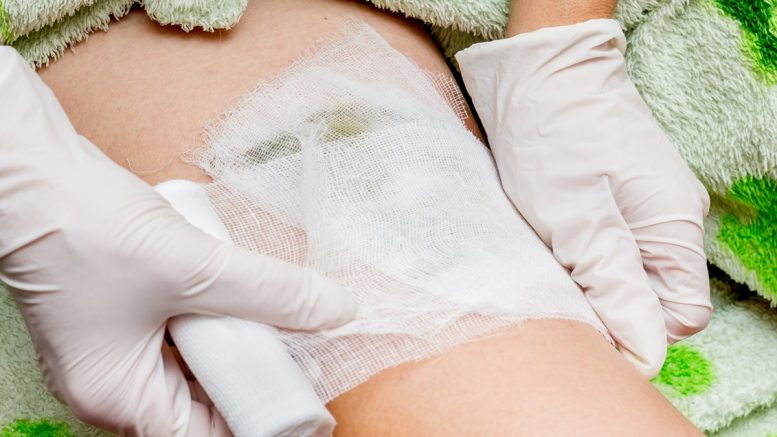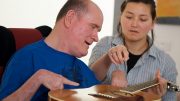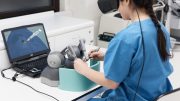It is estimated that wound care has cost the NHS up to £10 billion annually since the pandemic with a high proportion of these costs associated with the treatment and management of chronic or ‘hard to heal’ wounds.
Current gold standard treatment for healing and managing wounds, like venous leg ulcers, is compression therapy, typically in the form of two or four-layer bandaging, wraps, or hosiery over a wide choice of dressings. However, overall patient adherence to compression therapy is estimated between 12 and 52%, and recurrence rates are also relatively high – at 65% within five years – leaving many patients suffering with wounds on an ongoing basis.
Community nurse demand
Wound care is typically delivered by community nurses who visit patients’ homes to clean and re-dress wounds, with more severe cases being treated by wound specialists like tissue viability nurses or vascular surgeons in wound clinics or hospitals – and it is estimated that more than 80% of the total annual NHS cost for treating annual wounds is incurred in the community.
A 2020 study by Guest et al calculated the annual level of resources used in wound management, estimating “54.4 million district/community nurse visits, 53.6 million healthcare assistant visits and 28.1 million practice nurse visits”. These numbers indicate the high demand for wound care across the UK and the time and resources required from the NHS.
Re-evaluating methods of care
To help reduce these costs, and ensure patients’ wounds can heal as quickly as possible while reducing rates of recurrence, new methods of care are being evaluated that provide greater independence to able patients, helping them manage their own conditions or share their care with those around them (family and/or friends).
These new ways of delivering care – recognised as ‘shared care’ and ‘patient self-management’ – have proven to be effective in various areas of care, such as diabetes, and have the potential to improve health outcomes making wound care more accessible, scalable, and clinically effective. This also has the power to limit the number of required community nurse visits per patient, helping reduce the strain on healthcare professionals and the wider health system.
The role of self management
Patient self management (also known as self regulation, patient involvement/partnership, patient education and patient counselling) is becoming an increasingly important part of healthcare and recovery. Self care has a plethora of benefits including improved mood, reduced anxiety and increased trust. As NHS resources are stretched, patients who are able to play a more active role in their healing journey could reap more benefits than patients who are reliant on a caregiver or healthcare professional to deliver all aspects of treatment.
Although effective and important for healing progress, self-management does not come without its challenges. Not all patients are suitable for self-care – ideal candidates should be physically able, health literate, able to be involved in the decision making process, willing to take responsibility for their own care, and have a support system that can help where needed. Also paramount to successful self-management is the ability to identify any changes or developments in their wound that could be harmful, such as infections. In some cases, patients and healthcare professionals may also rely on telecommunications to keep in touch, but this would require reliable technology and a stable internet connection.
Despite these challenges, able patients typically benefit from having a more active role in their treatment. To support this initiative, the National Wound Care Strategy Programme (NWCSP) was commissioned by NHS England to enhance the prevention, management and treatment of wounds, including leg ulcers, providing relevant literature and video resources for patients, such as advice on how to self-care for wounds and sharing care with others.
The benefits of a shared care model
The value of shared care has been widely reported, and it is considered an ideal treatment model for engaged and capable patients, offering them the opportunity to further engage with their care process, supported by friends, family or a care-giver. For wounds, ‘shared care’ would enable patients living with chronic wounds to personalise their treatment plans and schedules, and take more control over their healing with the support of individuals beyond solely healthcare professionals.
Shared care models are reported to increase patient satisfaction with their care, as they take a more active role in their treatment rather than being a passive recipient. The involvement itself can improve wound outcomes but also contribute to reducing health costs and improved quality of life. In wound care, this role extends to an informal caregiver who can support the patient with day to day activities and assist with elements of wound care.
Shared wound care is currently being encouraged by clinicians where appropriate. Suitable patients and caregivers should demonstrate that they are relatively knowledgeable about their wound, and willing and able to make necessary changes to their lifestyle to enhance healing. Successful shared care requires regular discussion with the patient/carer, including motivational interviewing and attainable goal-setting to help them stay on track to achieve healing outcomes.
The help of MedTech
In an ideal world, patients would be able to bandage their own wounds to reduce the need for frequent visits from community nurses, however even where patients build the knowledge base to dress a wound independently, it is possible that not enough pressure will be applied to best support recovery. For venous leg ulcers, this can have significant negative impacts on the healing process.
The National Institute for Health and Care Excellence (NICE) states that: “the use [of compression bandages] calls for an expert knowledge of the elastic properties of the products and experience in the technique of providing careful graduated compression.” With patient self-management this becomes more troublesome and risks wounds not healing properly or healing more slowly – in some cases doing more harm than good.
However, as new solutions are adopted into care pathways with the aim of simplifying care and improving patient outcomes, innovations in MedTech are becoming increasingly designed for patients to be able to easily and safely self-administer or share their care. For example, a small non-invasive, wearable, neuromuscular electrostimulation device is now available that can be quickly and safely be applied and used alongside compression therapy to drive up adherence levels and accelerate wound healing for patients.
Although such solutions are not an alternative to standard care – and do not eliminate the need for healthcare professionals to provide care – they do have the power to significantly accelerate the rate of healing, resulting in less home and clinic visits and greatly reducing health care system costs.
A multi-pronged approach
To ensure the successful delivery of wound care in the UK, the healthcare system are working to embrace new methods of care that can give patients more involvement in their treatment. For wound care, this means giving able patients more of an active role in their recovery and involving them in the decision making process. Empowering patients in this way can increase adherence and concordance rates and ultimately give them greater hope throughout their treatment – a crucial point for those who are deeply impacted by their wounds.
The bigger picture indicates that self and shared care will deliver huge benefits to the wider healthcare system, releasing valuable community nurse time and resources and cutting costs in the process. As the NHS rolls out its virtual wards, the role of self and shared care will become all the more important and will help demonstrate that a unified effort from patients and healthcare professionals delivers the best outcomes for everyone.
By Bernard Ross, CEO at Sky Medical Technology





